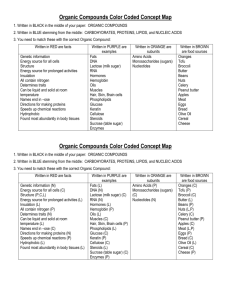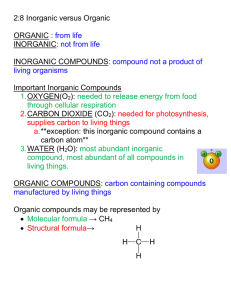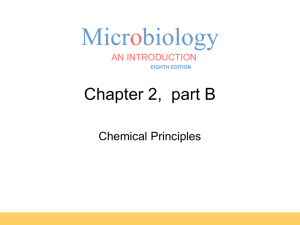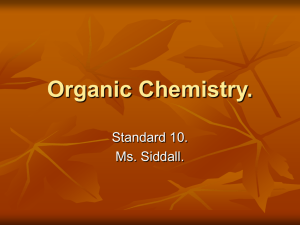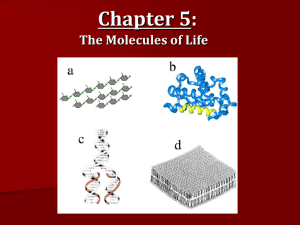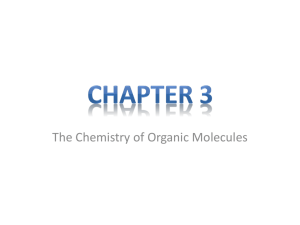Standard 1: CHEMISTRY OF LIFE –REVIEW OF BASICS O=C=O
advertisement
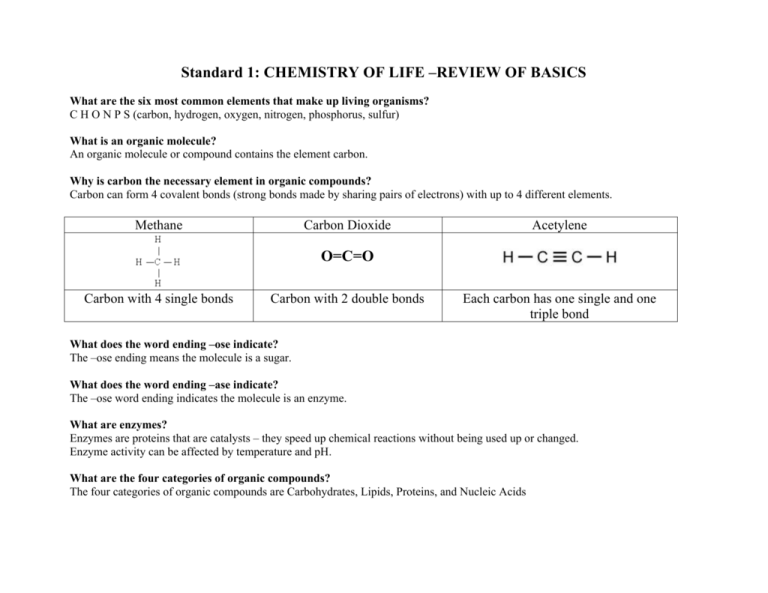
Standard 1: CHEMISTRY OF LIFE –REVIEW OF BASICS What are the six most common elements that make up living organisms? C H O N P S (carbon, hydrogen, oxygen, nitrogen, phosphorus, sulfur) What is an organic molecule? An organic molecule or compound contains the element carbon. Why is carbon the necessary element in organic compounds? Carbon can form 4 covalent bonds (strong bonds made by sharing pairs of electrons) with up to 4 different elements. Methane Carbon Dioxide Acetylene O=C=O Carbon with 4 single bonds Carbon with 2 double bonds Each carbon has one single and one triple bond What does the word ending –ose indicate? The –ose ending means the molecule is a sugar. What does the word ending –ase indicate? The –ose word ending indicates the molecule is an enzyme. What are enzymes? Enzymes are proteins that are catalysts – they speed up chemical reactions without being used up or changed. Enzyme activity can be affected by temperature and pH. What are the four categories of organic compounds? The four categories of organic compounds are Carbohydrates, Lipids, Proteins, and Nucleic Acids Complete this chart of the four major categories of organic compounds: CARBOHYDRATES ELEMENTS CHO MONOMERS Monosaccharides are simple (BUILDING sugars (glucose, galactose, BLOCKS) fructose) Sugar names end in -ose SHAPE/ STRUCTURE PROTEINS NUCLEIC ACIDS CHO Glycerol and fatty acids Fatty acids are long chains of hydrocarbons (C and H) CHON (sometimes S) Amino acids (20 different kinds) CHONP Nucleotide (made of a sugar, phosphate and nitrogen base) Amino Acid (-R group is different for each amino acid DNA is shaped like a double helix (twisted ladder) Glucose Starch is a chain of glucose molecules that are chemically bonded. TYPES AND FUNCTIONS LIPIDS Sugars – quick energy source Starches – stored energy for long-term use in plants Glycogen – animal starch Cellulose – structural component of plant cell walls Glycerol is a 3-carbon alcohol and each fatty acid is a long chain of carbon atoms with hydrogen atoms attached. Fats and oils: compact energy storage for longterm use and insulation Waxes: waterproofing Proteins are chains of amino acids Sequence of the amino acids determines the protein Proteins make up muscle, skin, hair, nails Most enzymes are proteins. Many enzyme names end in –ase (amylase, lipase) DNA contains genetic information (recipes to make proteins) RNA carries the information from the DNA to help make proteins



